Analyzing Gender Mainstreaming Strategy in Compassion Fund
VerifiedAdded on 2023/05/29
|15
|4156
|400
Report
AI Summary
This position paper examines gender equity within the Compassion Fund, a large international NGO, focusing on the challenges in achieving gender equality due to cultural discrimination and societal perceptions. It highlights the importance of gender mainstreaming as a strategy to promote gender equality in Compassion Fund's policies and programs from 2016 to 2019. The paper identifies issues such as lack of training, insufficient resource allocation, and a non-inclusive organizational culture as barriers to gender integration. It emphasizes the need for political will, organizational culture change, technical capacity building, and accountability to successfully integrate gender equity. Recommended actions include budgeting for gender activities, implementing clear promotion systems, and developing transparent HR policies to foster a more equitable environment. The paper advocates for increased awareness and training to address gender roles and responsibilities, ultimately promoting the success of Compassion Fund's programs through gender equality. Desklib provides a platform for students to access similar solved assignments and past papers.
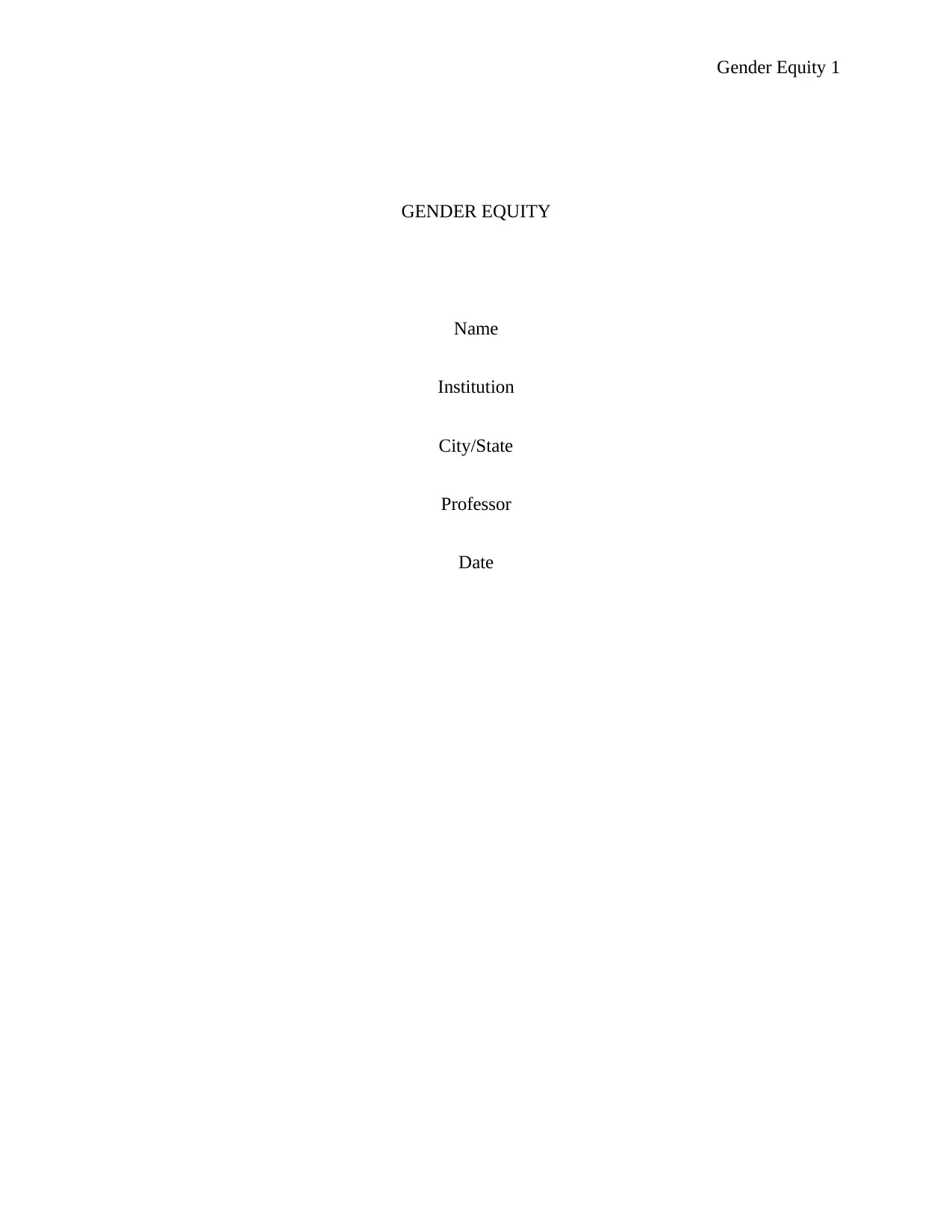
Gender Equity 1
GENDER EQUITY
Name
Institution
City/State
Professor
Date
GENDER EQUITY
Name
Institution
City/State
Professor
Date
Paraphrase This Document
Need a fresh take? Get an instant paraphrase of this document with our AI Paraphraser
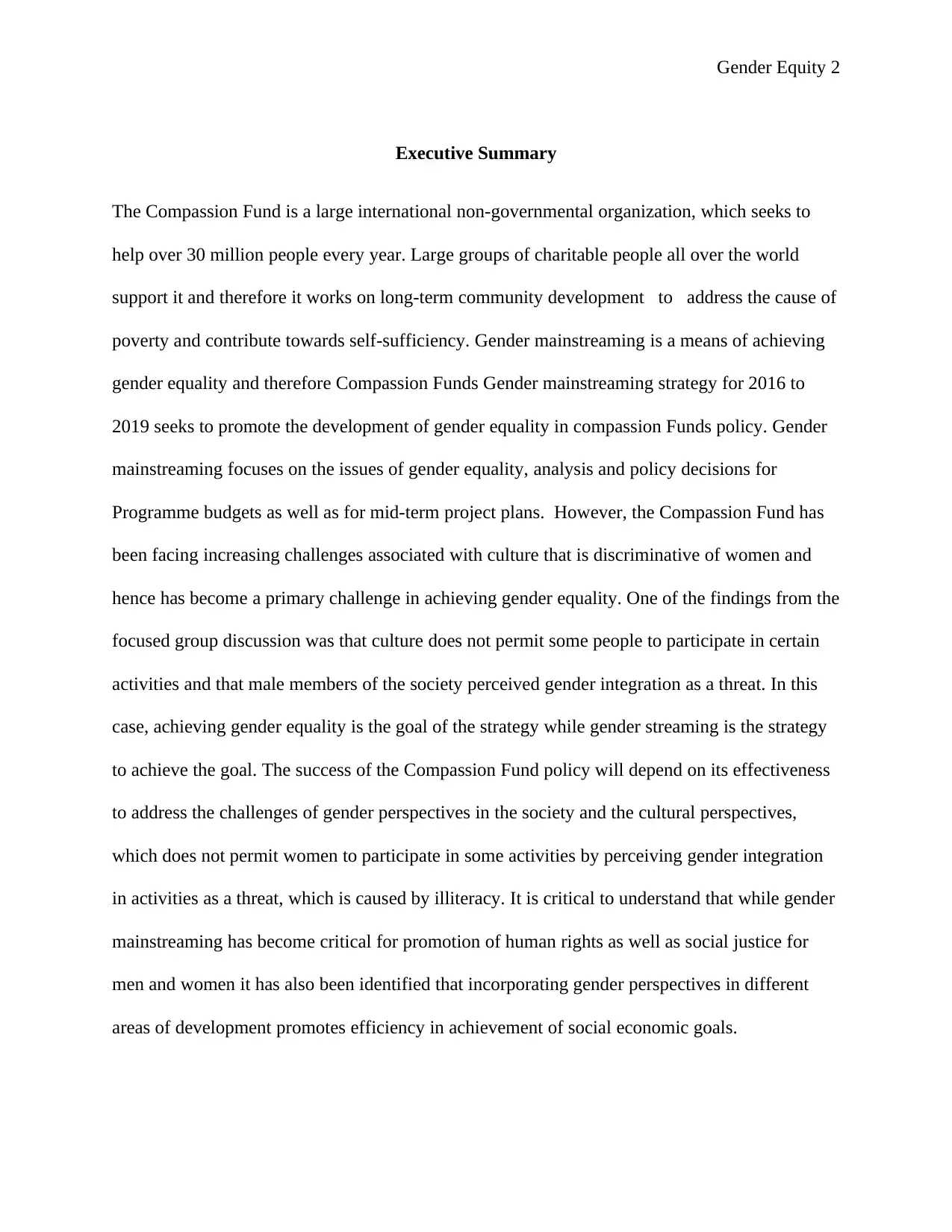
Gender Equity 2
Executive Summary
The Compassion Fund is a large international non-governmental organization, which seeks to
help over 30 million people every year. Large groups of charitable people all over the world
support it and therefore it works on long-term community development to address the cause of
poverty and contribute towards self-sufficiency. Gender mainstreaming is a means of achieving
gender equality and therefore Compassion Funds Gender mainstreaming strategy for 2016 to
2019 seeks to promote the development of gender equality in compassion Funds policy. Gender
mainstreaming focuses on the issues of gender equality, analysis and policy decisions for
Programme budgets as well as for mid-term project plans. However, the Compassion Fund has
been facing increasing challenges associated with culture that is discriminative of women and
hence has become a primary challenge in achieving gender equality. One of the findings from the
focused group discussion was that culture does not permit some people to participate in certain
activities and that male members of the society perceived gender integration as a threat. In this
case, achieving gender equality is the goal of the strategy while gender streaming is the strategy
to achieve the goal. The success of the Compassion Fund policy will depend on its effectiveness
to address the challenges of gender perspectives in the society and the cultural perspectives,
which does not permit women to participate in some activities by perceiving gender integration
in activities as a threat, which is caused by illiteracy. It is critical to understand that while gender
mainstreaming has become critical for promotion of human rights as well as social justice for
men and women it has also been identified that incorporating gender perspectives in different
areas of development promotes efficiency in achievement of social economic goals.
Executive Summary
The Compassion Fund is a large international non-governmental organization, which seeks to
help over 30 million people every year. Large groups of charitable people all over the world
support it and therefore it works on long-term community development to address the cause of
poverty and contribute towards self-sufficiency. Gender mainstreaming is a means of achieving
gender equality and therefore Compassion Funds Gender mainstreaming strategy for 2016 to
2019 seeks to promote the development of gender equality in compassion Funds policy. Gender
mainstreaming focuses on the issues of gender equality, analysis and policy decisions for
Programme budgets as well as for mid-term project plans. However, the Compassion Fund has
been facing increasing challenges associated with culture that is discriminative of women and
hence has become a primary challenge in achieving gender equality. One of the findings from the
focused group discussion was that culture does not permit some people to participate in certain
activities and that male members of the society perceived gender integration as a threat. In this
case, achieving gender equality is the goal of the strategy while gender streaming is the strategy
to achieve the goal. The success of the Compassion Fund policy will depend on its effectiveness
to address the challenges of gender perspectives in the society and the cultural perspectives,
which does not permit women to participate in some activities by perceiving gender integration
in activities as a threat, which is caused by illiteracy. It is critical to understand that while gender
mainstreaming has become critical for promotion of human rights as well as social justice for
men and women it has also been identified that incorporating gender perspectives in different
areas of development promotes efficiency in achievement of social economic goals.
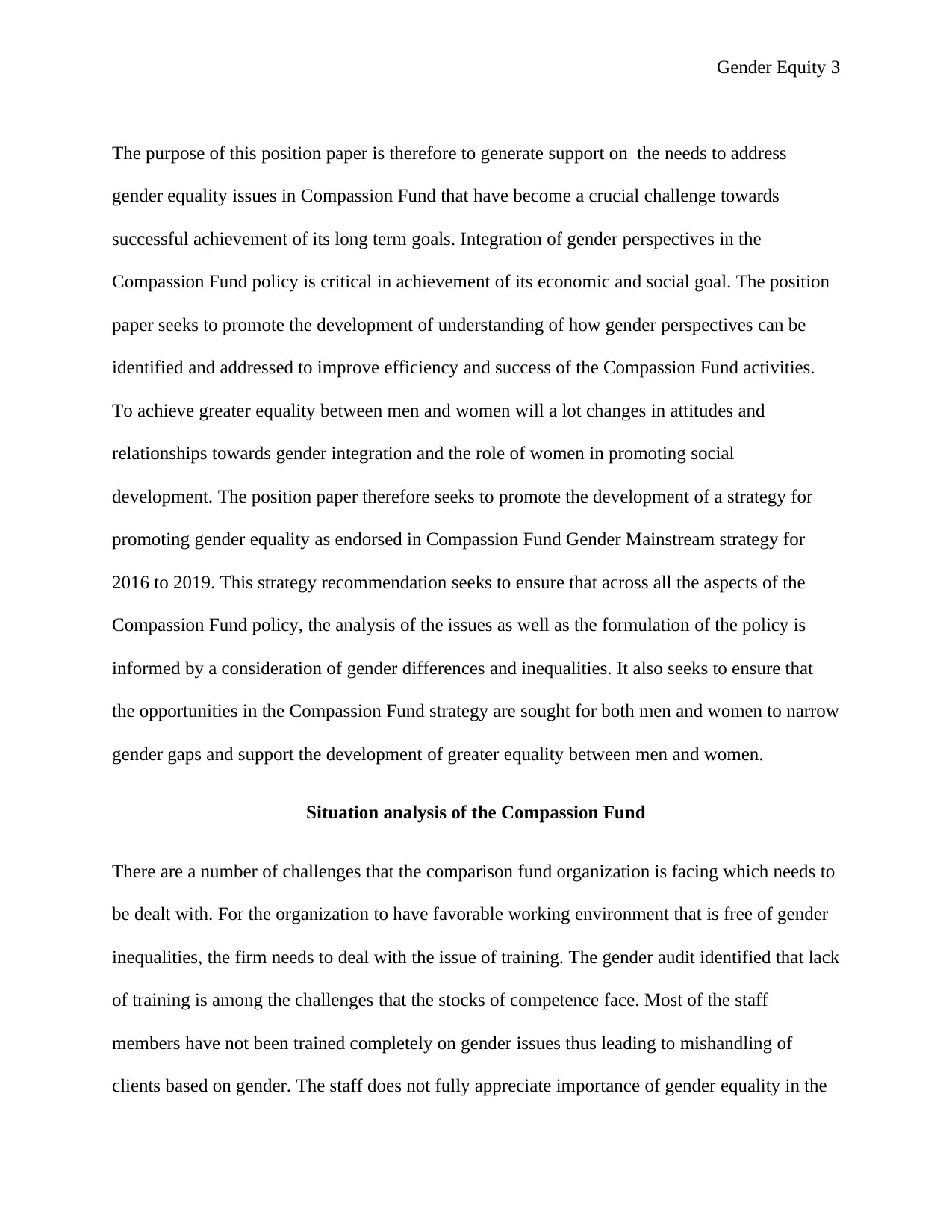
Gender Equity 3
The purpose of this position paper is therefore to generate support on the needs to address
gender equality issues in Compassion Fund that have become a crucial challenge towards
successful achievement of its long term goals. Integration of gender perspectives in the
Compassion Fund policy is critical in achievement of its economic and social goal. The position
paper seeks to promote the development of understanding of how gender perspectives can be
identified and addressed to improve efficiency and success of the Compassion Fund activities.
To achieve greater equality between men and women will a lot changes in attitudes and
relationships towards gender integration and the role of women in promoting social
development. The position paper therefore seeks to promote the development of a strategy for
promoting gender equality as endorsed in Compassion Fund Gender Mainstream strategy for
2016 to 2019. This strategy recommendation seeks to ensure that across all the aspects of the
Compassion Fund policy, the analysis of the issues as well as the formulation of the policy is
informed by a consideration of gender differences and inequalities. It also seeks to ensure that
the opportunities in the Compassion Fund strategy are sought for both men and women to narrow
gender gaps and support the development of greater equality between men and women.
Situation analysis of the Compassion Fund
There are a number of challenges that the comparison fund organization is facing which needs to
be dealt with. For the organization to have favorable working environment that is free of gender
inequalities, the firm needs to deal with the issue of training. The gender audit identified that lack
of training is among the challenges that the stocks of competence face. Most of the staff
members have not been trained completely on gender issues thus leading to mishandling of
clients based on gender. The staff does not fully appreciate importance of gender equality in the
The purpose of this position paper is therefore to generate support on the needs to address
gender equality issues in Compassion Fund that have become a crucial challenge towards
successful achievement of its long term goals. Integration of gender perspectives in the
Compassion Fund policy is critical in achievement of its economic and social goal. The position
paper seeks to promote the development of understanding of how gender perspectives can be
identified and addressed to improve efficiency and success of the Compassion Fund activities.
To achieve greater equality between men and women will a lot changes in attitudes and
relationships towards gender integration and the role of women in promoting social
development. The position paper therefore seeks to promote the development of a strategy for
promoting gender equality as endorsed in Compassion Fund Gender Mainstream strategy for
2016 to 2019. This strategy recommendation seeks to ensure that across all the aspects of the
Compassion Fund policy, the analysis of the issues as well as the formulation of the policy is
informed by a consideration of gender differences and inequalities. It also seeks to ensure that
the opportunities in the Compassion Fund strategy are sought for both men and women to narrow
gender gaps and support the development of greater equality between men and women.
Situation analysis of the Compassion Fund
There are a number of challenges that the comparison fund organization is facing which needs to
be dealt with. For the organization to have favorable working environment that is free of gender
inequalities, the firm needs to deal with the issue of training. The gender audit identified that lack
of training is among the challenges that the stocks of competence face. Most of the staff
members have not been trained completely on gender issues thus leading to mishandling of
clients based on gender. The staff does not fully appreciate importance of gender equality in the
⊘ This is a preview!⊘
Do you want full access?
Subscribe today to unlock all pages.

Trusted by 1+ million students worldwide
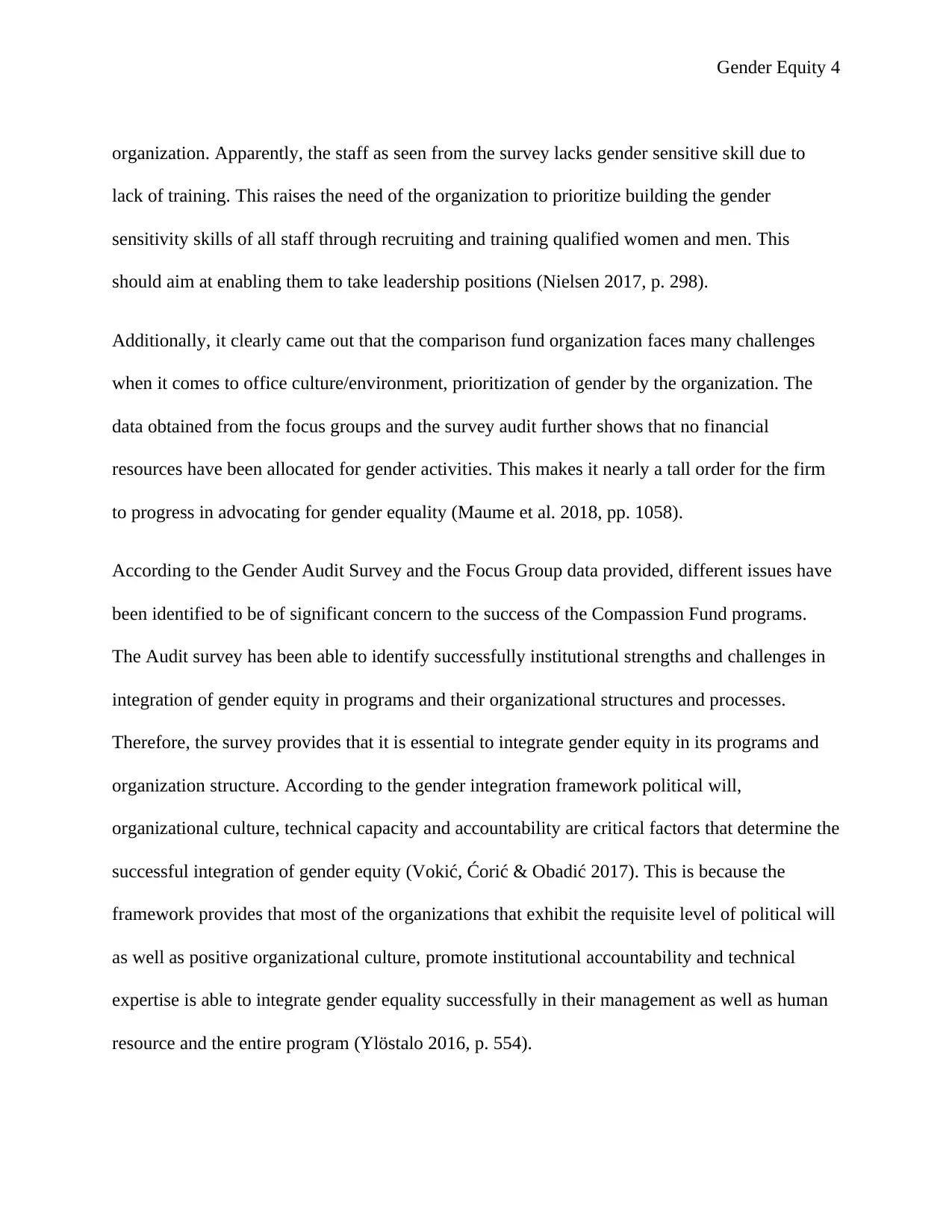
Gender Equity 4
organization. Apparently, the staff as seen from the survey lacks gender sensitive skill due to
lack of training. This raises the need of the organization to prioritize building the gender
sensitivity skills of all staff through recruiting and training qualified women and men. This
should aim at enabling them to take leadership positions (Nielsen 2017, p. 298).
Additionally, it clearly came out that the comparison fund organization faces many challenges
when it comes to office culture/environment, prioritization of gender by the organization. The
data obtained from the focus groups and the survey audit further shows that no financial
resources have been allocated for gender activities. This makes it nearly a tall order for the firm
to progress in advocating for gender equality (Maume et al. 2018, pp. 1058).
According to the Gender Audit Survey and the Focus Group data provided, different issues have
been identified to be of significant concern to the success of the Compassion Fund programs.
The Audit survey has been able to identify successfully institutional strengths and challenges in
integration of gender equity in programs and their organizational structures and processes.
Therefore, the survey provides that it is essential to integrate gender equity in its programs and
organization structure. According to the gender integration framework political will,
organizational culture, technical capacity and accountability are critical factors that determine the
successful integration of gender equity (Vokić, Ćorić & Obadić 2017). This is because the
framework provides that most of the organizations that exhibit the requisite level of political will
as well as positive organizational culture, promote institutional accountability and technical
expertise is able to integrate gender equality successfully in their management as well as human
resource and the entire program (Ylöstalo 2016, p. 554).
organization. Apparently, the staff as seen from the survey lacks gender sensitive skill due to
lack of training. This raises the need of the organization to prioritize building the gender
sensitivity skills of all staff through recruiting and training qualified women and men. This
should aim at enabling them to take leadership positions (Nielsen 2017, p. 298).
Additionally, it clearly came out that the comparison fund organization faces many challenges
when it comes to office culture/environment, prioritization of gender by the organization. The
data obtained from the focus groups and the survey audit further shows that no financial
resources have been allocated for gender activities. This makes it nearly a tall order for the firm
to progress in advocating for gender equality (Maume et al. 2018, pp. 1058).
According to the Gender Audit Survey and the Focus Group data provided, different issues have
been identified to be of significant concern to the success of the Compassion Fund programs.
The Audit survey has been able to identify successfully institutional strengths and challenges in
integration of gender equity in programs and their organizational structures and processes.
Therefore, the survey provides that it is essential to integrate gender equity in its programs and
organization structure. According to the gender integration framework political will,
organizational culture, technical capacity and accountability are critical factors that determine the
successful integration of gender equity (Vokić, Ćorić & Obadić 2017). This is because the
framework provides that most of the organizations that exhibit the requisite level of political will
as well as positive organizational culture, promote institutional accountability and technical
expertise is able to integrate gender equality successfully in their management as well as human
resource and the entire program (Ylöstalo 2016, p. 554).
Paraphrase This Document
Need a fresh take? Get an instant paraphrase of this document with our AI Paraphraser
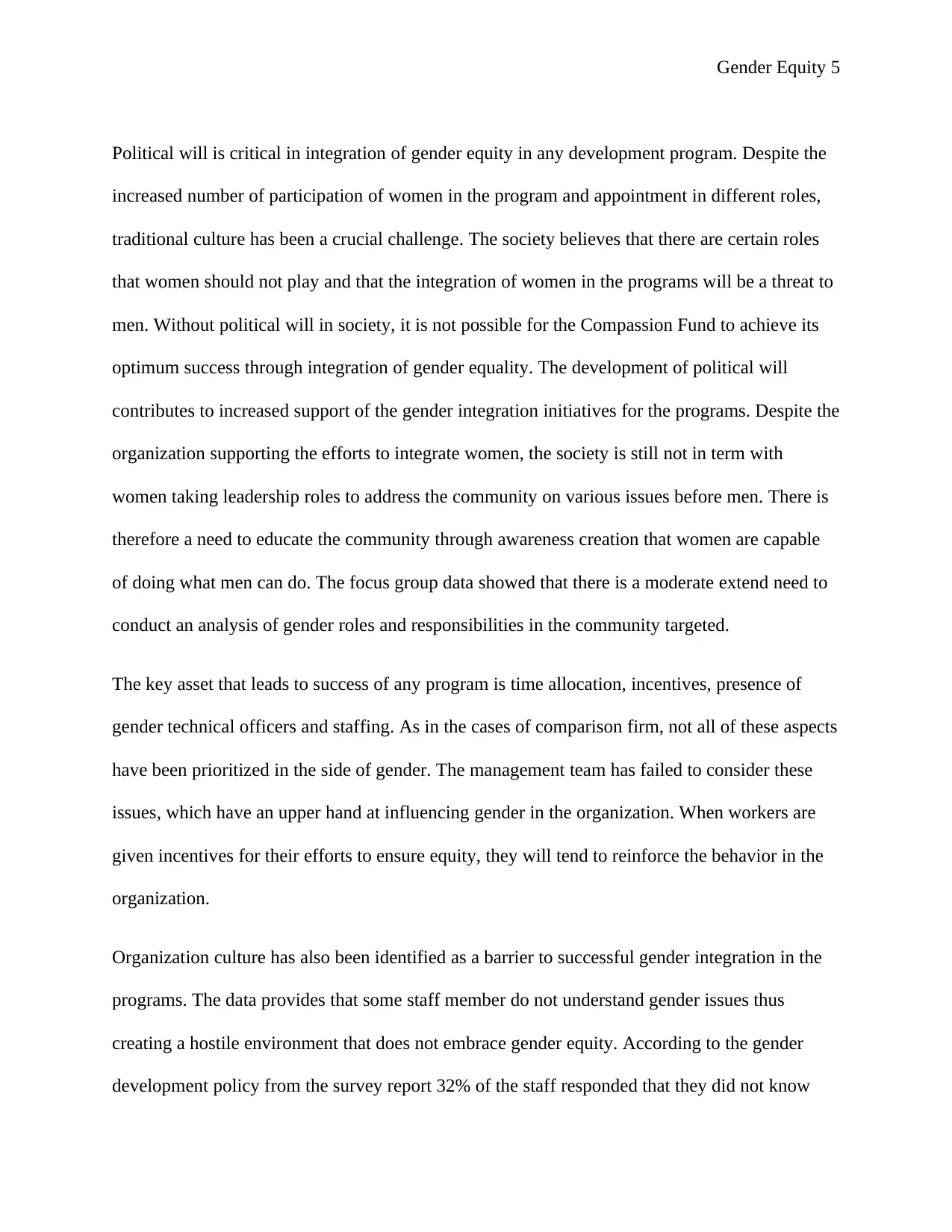
Gender Equity 5
Political will is critical in integration of gender equity in any development program. Despite the
increased number of participation of women in the program and appointment in different roles,
traditional culture has been a crucial challenge. The society believes that there are certain roles
that women should not play and that the integration of women in the programs will be a threat to
men. Without political will in society, it is not possible for the Compassion Fund to achieve its
optimum success through integration of gender equality. The development of political will
contributes to increased support of the gender integration initiatives for the programs. Despite the
organization supporting the efforts to integrate women, the society is still not in term with
women taking leadership roles to address the community on various issues before men. There is
therefore a need to educate the community through awareness creation that women are capable
of doing what men can do. The focus group data showed that there is a moderate extend need to
conduct an analysis of gender roles and responsibilities in the community targeted.
The key asset that leads to success of any program is time allocation, incentives, presence of
gender technical officers and staffing. As in the cases of comparison firm, not all of these aspects
have been prioritized in the side of gender. The management team has failed to consider these
issues, which have an upper hand at influencing gender in the organization. When workers are
given incentives for their efforts to ensure equity, they will tend to reinforce the behavior in the
organization.
Organization culture has also been identified as a barrier to successful gender integration in the
programs. The data provides that some staff member do not understand gender issues thus
creating a hostile environment that does not embrace gender equity. According to the gender
development policy from the survey report 32% of the staff responded that they did not know
Political will is critical in integration of gender equity in any development program. Despite the
increased number of participation of women in the program and appointment in different roles,
traditional culture has been a crucial challenge. The society believes that there are certain roles
that women should not play and that the integration of women in the programs will be a threat to
men. Without political will in society, it is not possible for the Compassion Fund to achieve its
optimum success through integration of gender equality. The development of political will
contributes to increased support of the gender integration initiatives for the programs. Despite the
organization supporting the efforts to integrate women, the society is still not in term with
women taking leadership roles to address the community on various issues before men. There is
therefore a need to educate the community through awareness creation that women are capable
of doing what men can do. The focus group data showed that there is a moderate extend need to
conduct an analysis of gender roles and responsibilities in the community targeted.
The key asset that leads to success of any program is time allocation, incentives, presence of
gender technical officers and staffing. As in the cases of comparison firm, not all of these aspects
have been prioritized in the side of gender. The management team has failed to consider these
issues, which have an upper hand at influencing gender in the organization. When workers are
given incentives for their efforts to ensure equity, they will tend to reinforce the behavior in the
organization.
Organization culture has also been identified as a barrier to successful gender integration in the
programs. The data provides that some staff member do not understand gender issues thus
creating a hostile environment that does not embrace gender equity. According to the gender
development policy from the survey report 32% of the staff responded that they did not know
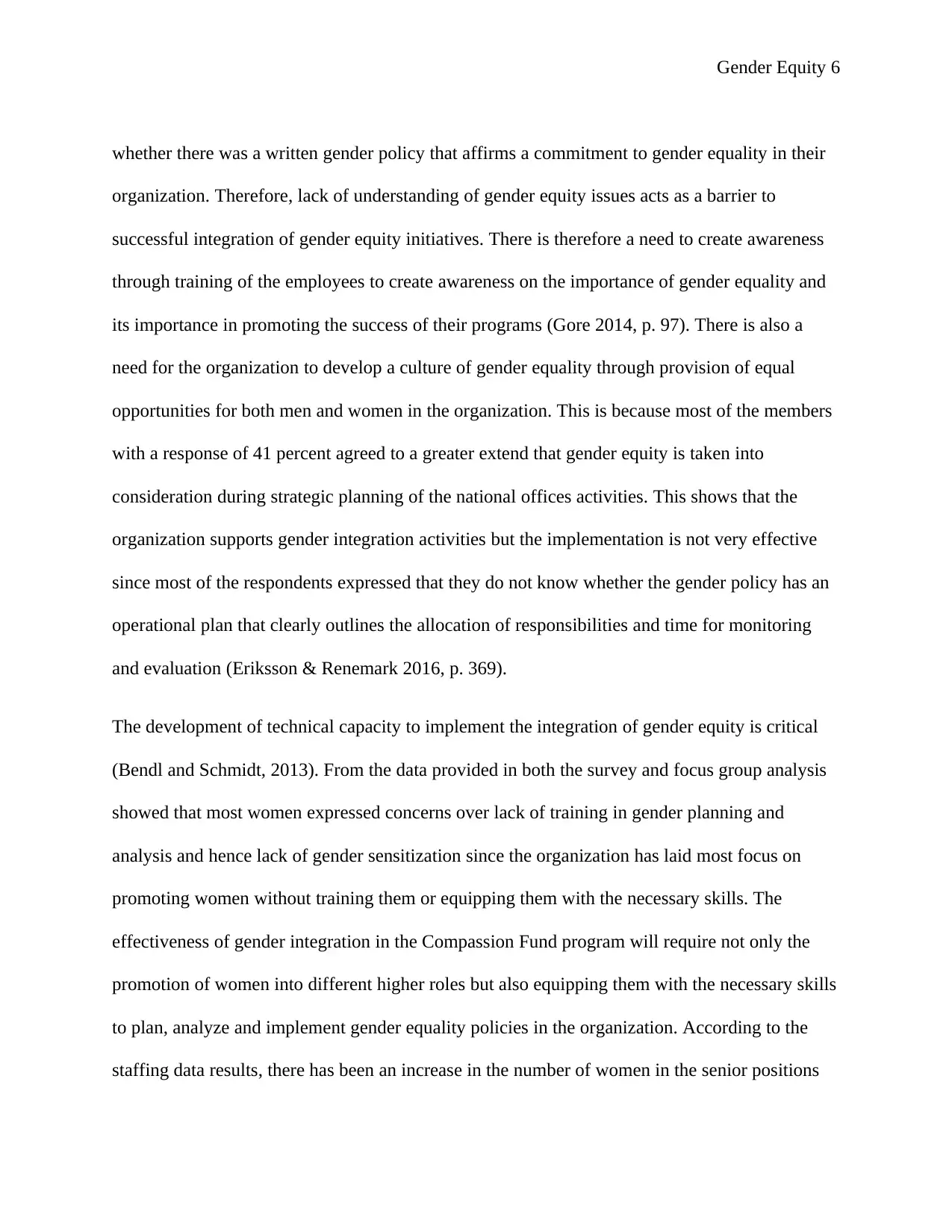
Gender Equity 6
whether there was a written gender policy that affirms a commitment to gender equality in their
organization. Therefore, lack of understanding of gender equity issues acts as a barrier to
successful integration of gender equity initiatives. There is therefore a need to create awareness
through training of the employees to create awareness on the importance of gender equality and
its importance in promoting the success of their programs (Gore 2014, p. 97). There is also a
need for the organization to develop a culture of gender equality through provision of equal
opportunities for both men and women in the organization. This is because most of the members
with a response of 41 percent agreed to a greater extend that gender equity is taken into
consideration during strategic planning of the national offices activities. This shows that the
organization supports gender integration activities but the implementation is not very effective
since most of the respondents expressed that they do not know whether the gender policy has an
operational plan that clearly outlines the allocation of responsibilities and time for monitoring
and evaluation (Eriksson & Renemark 2016, p. 369).
The development of technical capacity to implement the integration of gender equity is critical
(Bendl and Schmidt, 2013). From the data provided in both the survey and focus group analysis
showed that most women expressed concerns over lack of training in gender planning and
analysis and hence lack of gender sensitization since the organization has laid most focus on
promoting women without training them or equipping them with the necessary skills. The
effectiveness of gender integration in the Compassion Fund program will require not only the
promotion of women into different higher roles but also equipping them with the necessary skills
to plan, analyze and implement gender equality policies in the organization. According to the
staffing data results, there has been an increase in the number of women in the senior positions
whether there was a written gender policy that affirms a commitment to gender equality in their
organization. Therefore, lack of understanding of gender equity issues acts as a barrier to
successful integration of gender equity initiatives. There is therefore a need to create awareness
through training of the employees to create awareness on the importance of gender equality and
its importance in promoting the success of their programs (Gore 2014, p. 97). There is also a
need for the organization to develop a culture of gender equality through provision of equal
opportunities for both men and women in the organization. This is because most of the members
with a response of 41 percent agreed to a greater extend that gender equity is taken into
consideration during strategic planning of the national offices activities. This shows that the
organization supports gender integration activities but the implementation is not very effective
since most of the respondents expressed that they do not know whether the gender policy has an
operational plan that clearly outlines the allocation of responsibilities and time for monitoring
and evaluation (Eriksson & Renemark 2016, p. 369).
The development of technical capacity to implement the integration of gender equity is critical
(Bendl and Schmidt, 2013). From the data provided in both the survey and focus group analysis
showed that most women expressed concerns over lack of training in gender planning and
analysis and hence lack of gender sensitization since the organization has laid most focus on
promoting women without training them or equipping them with the necessary skills. The
effectiveness of gender integration in the Compassion Fund program will require not only the
promotion of women into different higher roles but also equipping them with the necessary skills
to plan, analyze and implement gender equality policies in the organization. According to the
staffing data results, there has been an increase in the number of women in the senior positions
⊘ This is a preview!⊘
Do you want full access?
Subscribe today to unlock all pages.

Trusted by 1+ million students worldwide
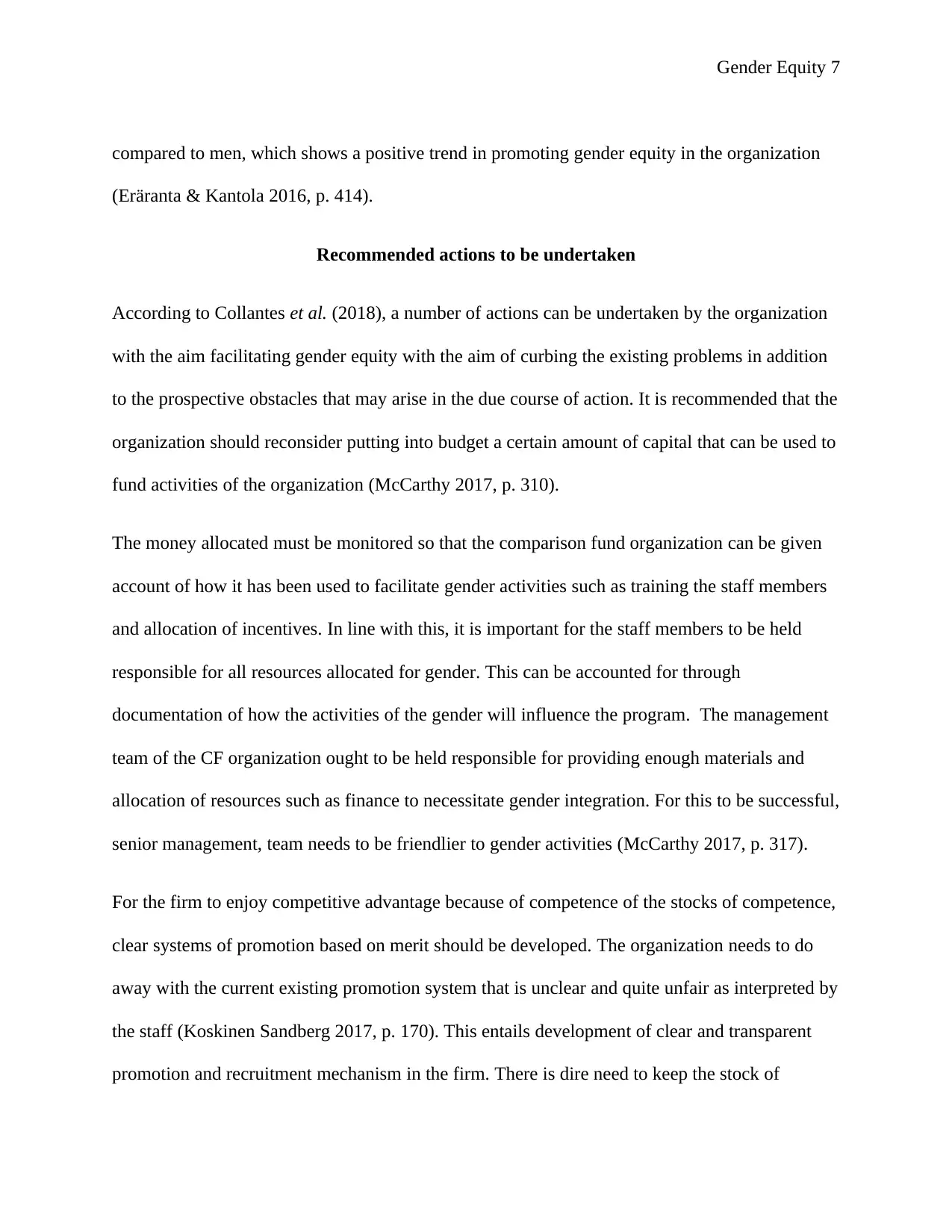
Gender Equity 7
compared to men, which shows a positive trend in promoting gender equity in the organization
(Eräranta & Kantola 2016, p. 414).
Recommended actions to be undertaken
According to Collantes et al. (2018), a number of actions can be undertaken by the organization
with the aim facilitating gender equity with the aim of curbing the existing problems in addition
to the prospective obstacles that may arise in the due course of action. It is recommended that the
organization should reconsider putting into budget a certain amount of capital that can be used to
fund activities of the organization (McCarthy 2017, p. 310).
The money allocated must be monitored so that the comparison fund organization can be given
account of how it has been used to facilitate gender activities such as training the staff members
and allocation of incentives. In line with this, it is important for the staff members to be held
responsible for all resources allocated for gender. This can be accounted for through
documentation of how the activities of the gender will influence the program. The management
team of the CF organization ought to be held responsible for providing enough materials and
allocation of resources such as finance to necessitate gender integration. For this to be successful,
senior management, team needs to be friendlier to gender activities (McCarthy 2017, p. 317).
For the firm to enjoy competitive advantage because of competence of the stocks of competence,
clear systems of promotion based on merit should be developed. The organization needs to do
away with the current existing promotion system that is unclear and quite unfair as interpreted by
the staff (Koskinen Sandberg 2017, p. 170). This entails development of clear and transparent
promotion and recruitment mechanism in the firm. There is dire need to keep the stock of
compared to men, which shows a positive trend in promoting gender equity in the organization
(Eräranta & Kantola 2016, p. 414).
Recommended actions to be undertaken
According to Collantes et al. (2018), a number of actions can be undertaken by the organization
with the aim facilitating gender equity with the aim of curbing the existing problems in addition
to the prospective obstacles that may arise in the due course of action. It is recommended that the
organization should reconsider putting into budget a certain amount of capital that can be used to
fund activities of the organization (McCarthy 2017, p. 310).
The money allocated must be monitored so that the comparison fund organization can be given
account of how it has been used to facilitate gender activities such as training the staff members
and allocation of incentives. In line with this, it is important for the staff members to be held
responsible for all resources allocated for gender. This can be accounted for through
documentation of how the activities of the gender will influence the program. The management
team of the CF organization ought to be held responsible for providing enough materials and
allocation of resources such as finance to necessitate gender integration. For this to be successful,
senior management, team needs to be friendlier to gender activities (McCarthy 2017, p. 317).
For the firm to enjoy competitive advantage because of competence of the stocks of competence,
clear systems of promotion based on merit should be developed. The organization needs to do
away with the current existing promotion system that is unclear and quite unfair as interpreted by
the staff (Koskinen Sandberg 2017, p. 170). This entails development of clear and transparent
promotion and recruitment mechanism in the firm. There is dire need to keep the stock of
Paraphrase This Document
Need a fresh take? Get an instant paraphrase of this document with our AI Paraphraser
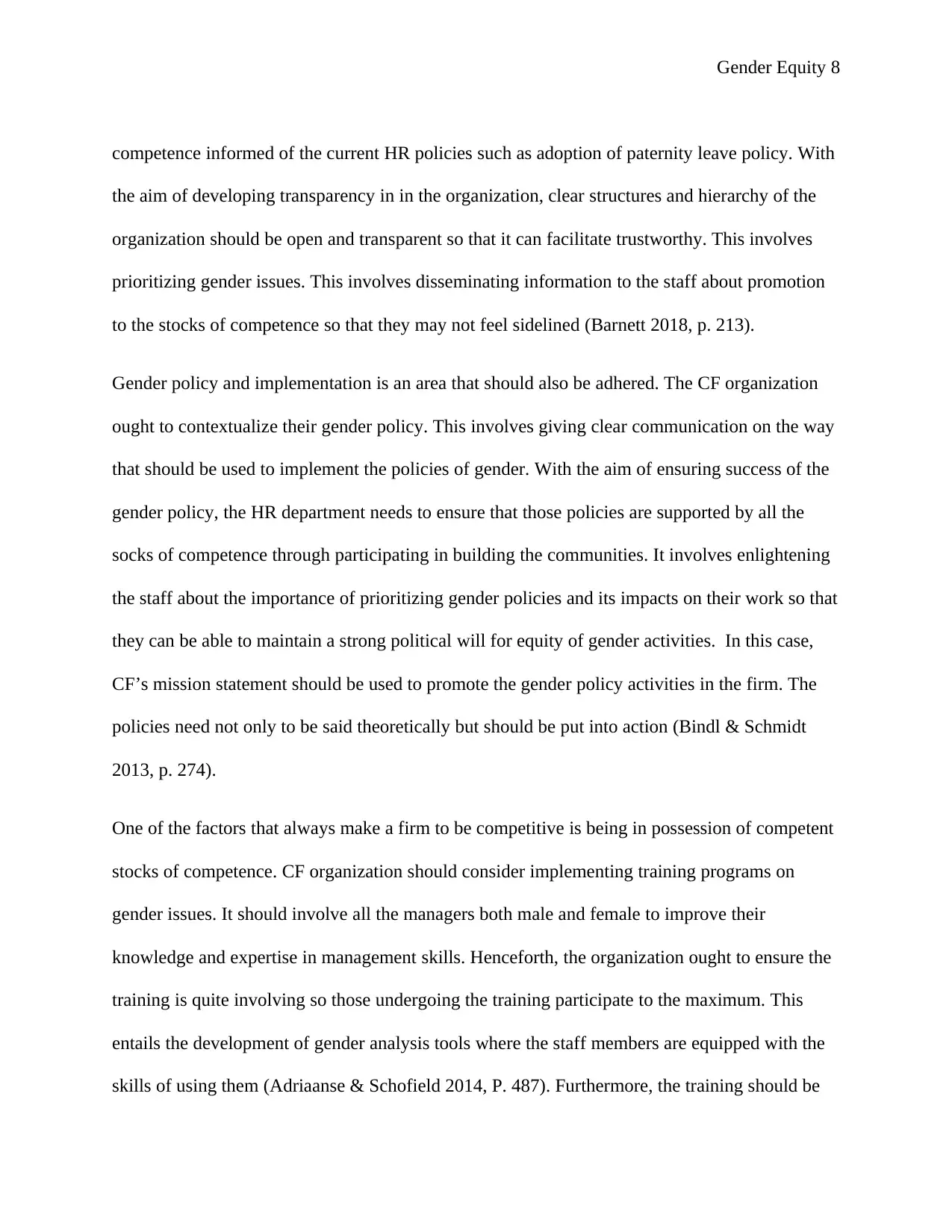
Gender Equity 8
competence informed of the current HR policies such as adoption of paternity leave policy. With
the aim of developing transparency in in the organization, clear structures and hierarchy of the
organization should be open and transparent so that it can facilitate trustworthy. This involves
prioritizing gender issues. This involves disseminating information to the staff about promotion
to the stocks of competence so that they may not feel sidelined (Barnett 2018, p. 213).
Gender policy and implementation is an area that should also be adhered. The CF organization
ought to contextualize their gender policy. This involves giving clear communication on the way
that should be used to implement the policies of gender. With the aim of ensuring success of the
gender policy, the HR department needs to ensure that those policies are supported by all the
socks of competence through participating in building the communities. It involves enlightening
the staff about the importance of prioritizing gender policies and its impacts on their work so that
they can be able to maintain a strong political will for equity of gender activities. In this case,
CF’s mission statement should be used to promote the gender policy activities in the firm. The
policies need not only to be said theoretically but should be put into action (Bindl & Schmidt
2013, p. 274).
One of the factors that always make a firm to be competitive is being in possession of competent
stocks of competence. CF organization should consider implementing training programs on
gender issues. It should involve all the managers both male and female to improve their
knowledge and expertise in management skills. Henceforth, the organization ought to ensure the
training is quite involving so those undergoing the training participate to the maximum. This
entails the development of gender analysis tools where the staff members are equipped with the
skills of using them (Adriaanse & Schofield 2014, P. 487). Furthermore, the training should be
competence informed of the current HR policies such as adoption of paternity leave policy. With
the aim of developing transparency in in the organization, clear structures and hierarchy of the
organization should be open and transparent so that it can facilitate trustworthy. This involves
prioritizing gender issues. This involves disseminating information to the staff about promotion
to the stocks of competence so that they may not feel sidelined (Barnett 2018, p. 213).
Gender policy and implementation is an area that should also be adhered. The CF organization
ought to contextualize their gender policy. This involves giving clear communication on the way
that should be used to implement the policies of gender. With the aim of ensuring success of the
gender policy, the HR department needs to ensure that those policies are supported by all the
socks of competence through participating in building the communities. It involves enlightening
the staff about the importance of prioritizing gender policies and its impacts on their work so that
they can be able to maintain a strong political will for equity of gender activities. In this case,
CF’s mission statement should be used to promote the gender policy activities in the firm. The
policies need not only to be said theoretically but should be put into action (Bindl & Schmidt
2013, p. 274).
One of the factors that always make a firm to be competitive is being in possession of competent
stocks of competence. CF organization should consider implementing training programs on
gender issues. It should involve all the managers both male and female to improve their
knowledge and expertise in management skills. Henceforth, the organization ought to ensure the
training is quite involving so those undergoing the training participate to the maximum. This
entails the development of gender analysis tools where the staff members are equipped with the
skills of using them (Adriaanse & Schofield 2014, P. 487). Furthermore, the training should be
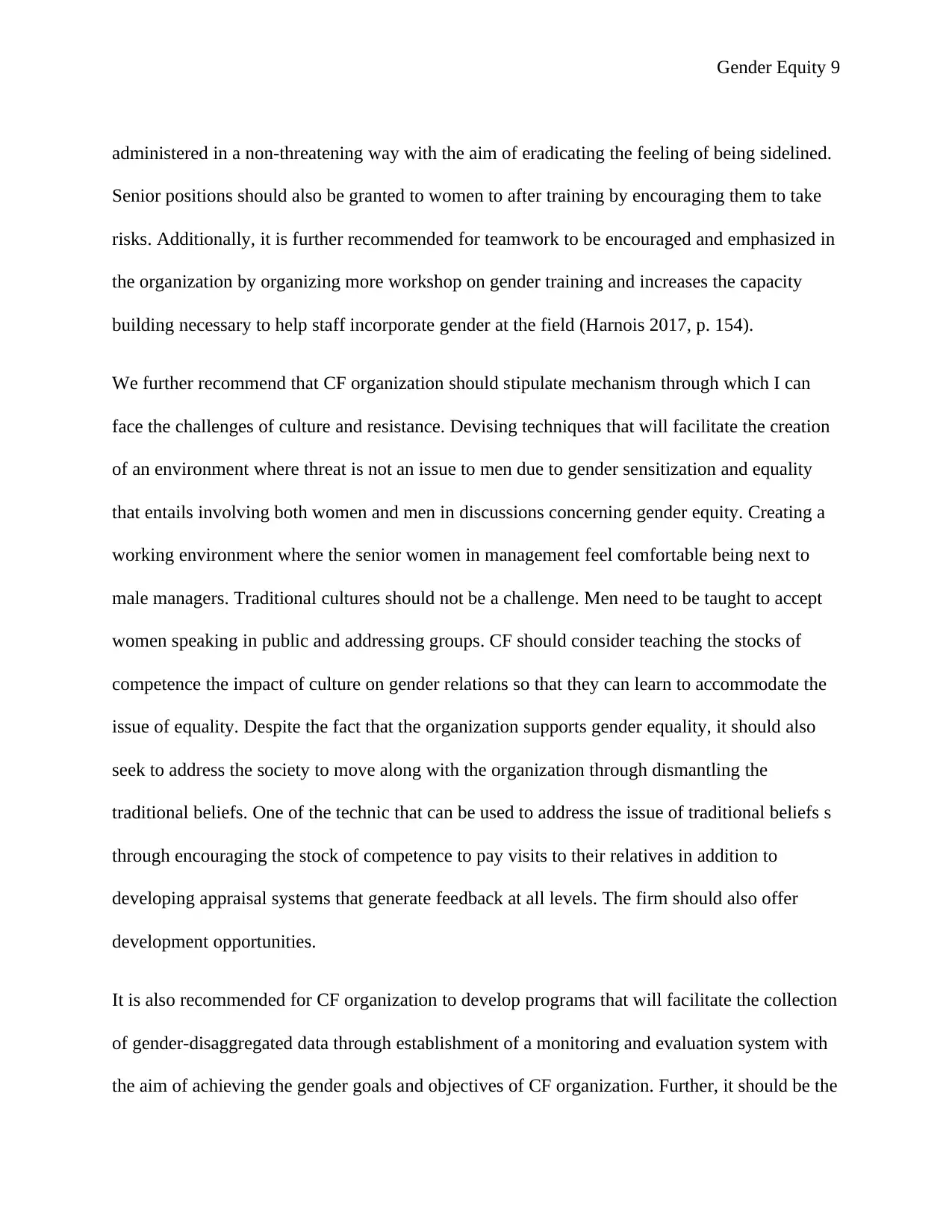
Gender Equity 9
administered in a non-threatening way with the aim of eradicating the feeling of being sidelined.
Senior positions should also be granted to women to after training by encouraging them to take
risks. Additionally, it is further recommended for teamwork to be encouraged and emphasized in
the organization by organizing more workshop on gender training and increases the capacity
building necessary to help staff incorporate gender at the field (Harnois 2017, p. 154).
We further recommend that CF organization should stipulate mechanism through which I can
face the challenges of culture and resistance. Devising techniques that will facilitate the creation
of an environment where threat is not an issue to men due to gender sensitization and equality
that entails involving both women and men in discussions concerning gender equity. Creating a
working environment where the senior women in management feel comfortable being next to
male managers. Traditional cultures should not be a challenge. Men need to be taught to accept
women speaking in public and addressing groups. CF should consider teaching the stocks of
competence the impact of culture on gender relations so that they can learn to accommodate the
issue of equality. Despite the fact that the organization supports gender equality, it should also
seek to address the society to move along with the organization through dismantling the
traditional beliefs. One of the technic that can be used to address the issue of traditional beliefs s
through encouraging the stock of competence to pay visits to their relatives in addition to
developing appraisal systems that generate feedback at all levels. The firm should also offer
development opportunities.
It is also recommended for CF organization to develop programs that will facilitate the collection
of gender-disaggregated data through establishment of a monitoring and evaluation system with
the aim of achieving the gender goals and objectives of CF organization. Further, it should be the
administered in a non-threatening way with the aim of eradicating the feeling of being sidelined.
Senior positions should also be granted to women to after training by encouraging them to take
risks. Additionally, it is further recommended for teamwork to be encouraged and emphasized in
the organization by organizing more workshop on gender training and increases the capacity
building necessary to help staff incorporate gender at the field (Harnois 2017, p. 154).
We further recommend that CF organization should stipulate mechanism through which I can
face the challenges of culture and resistance. Devising techniques that will facilitate the creation
of an environment where threat is not an issue to men due to gender sensitization and equality
that entails involving both women and men in discussions concerning gender equity. Creating a
working environment where the senior women in management feel comfortable being next to
male managers. Traditional cultures should not be a challenge. Men need to be taught to accept
women speaking in public and addressing groups. CF should consider teaching the stocks of
competence the impact of culture on gender relations so that they can learn to accommodate the
issue of equality. Despite the fact that the organization supports gender equality, it should also
seek to address the society to move along with the organization through dismantling the
traditional beliefs. One of the technic that can be used to address the issue of traditional beliefs s
through encouraging the stock of competence to pay visits to their relatives in addition to
developing appraisal systems that generate feedback at all levels. The firm should also offer
development opportunities.
It is also recommended for CF organization to develop programs that will facilitate the collection
of gender-disaggregated data through establishment of a monitoring and evaluation system with
the aim of achieving the gender goals and objectives of CF organization. Further, it should be the
⊘ This is a preview!⊘
Do you want full access?
Subscribe today to unlock all pages.

Trusted by 1+ million students worldwide
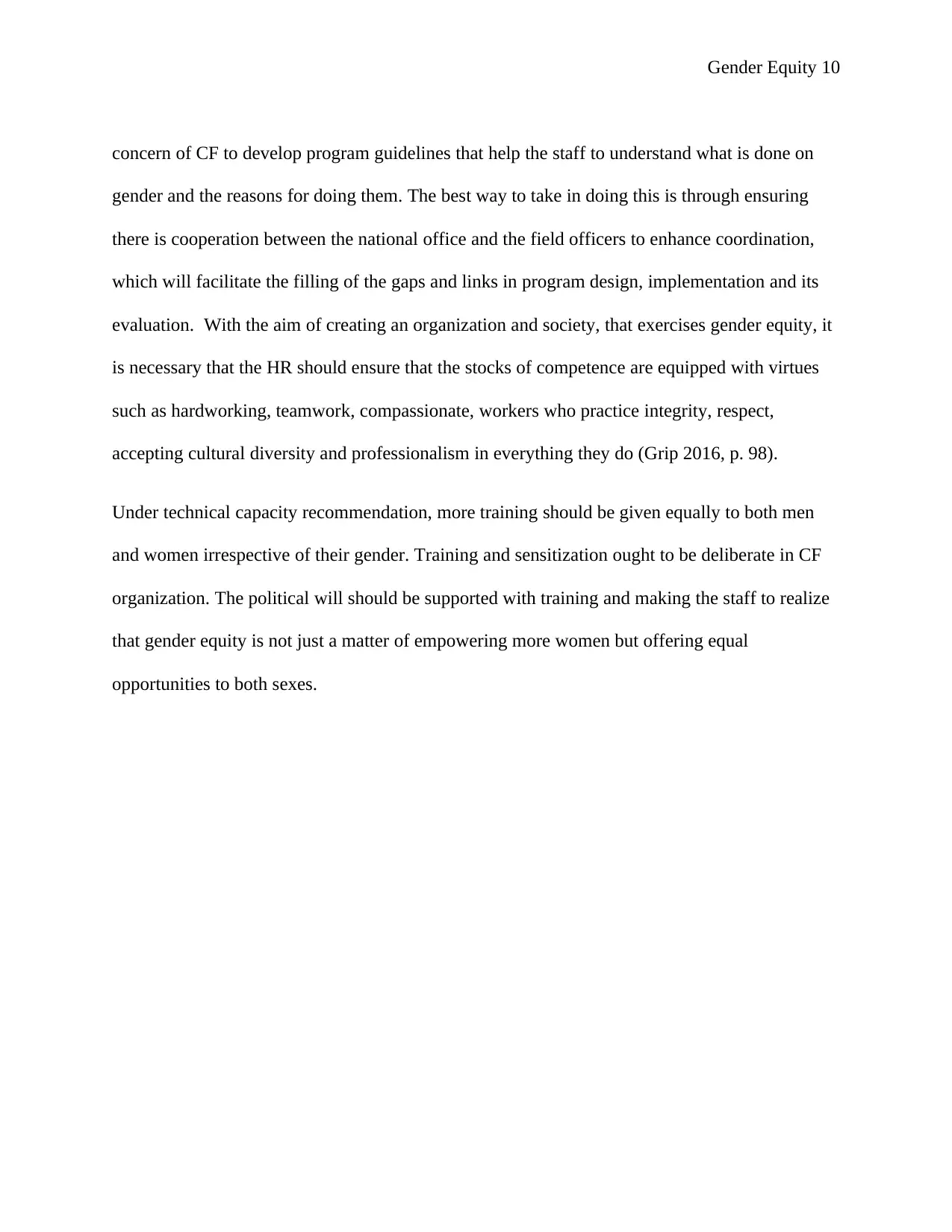
Gender Equity 10
concern of CF to develop program guidelines that help the staff to understand what is done on
gender and the reasons for doing them. The best way to take in doing this is through ensuring
there is cooperation between the national office and the field officers to enhance coordination,
which will facilitate the filling of the gaps and links in program design, implementation and its
evaluation. With the aim of creating an organization and society, that exercises gender equity, it
is necessary that the HR should ensure that the stocks of competence are equipped with virtues
such as hardworking, teamwork, compassionate, workers who practice integrity, respect,
accepting cultural diversity and professionalism in everything they do (Grip 2016, p. 98).
Under technical capacity recommendation, more training should be given equally to both men
and women irrespective of their gender. Training and sensitization ought to be deliberate in CF
organization. The political will should be supported with training and making the staff to realize
that gender equity is not just a matter of empowering more women but offering equal
opportunities to both sexes.
concern of CF to develop program guidelines that help the staff to understand what is done on
gender and the reasons for doing them. The best way to take in doing this is through ensuring
there is cooperation between the national office and the field officers to enhance coordination,
which will facilitate the filling of the gaps and links in program design, implementation and its
evaluation. With the aim of creating an organization and society, that exercises gender equity, it
is necessary that the HR should ensure that the stocks of competence are equipped with virtues
such as hardworking, teamwork, compassionate, workers who practice integrity, respect,
accepting cultural diversity and professionalism in everything they do (Grip 2016, p. 98).
Under technical capacity recommendation, more training should be given equally to both men
and women irrespective of their gender. Training and sensitization ought to be deliberate in CF
organization. The political will should be supported with training and making the staff to realize
that gender equity is not just a matter of empowering more women but offering equal
opportunities to both sexes.
Paraphrase This Document
Need a fresh take? Get an instant paraphrase of this document with our AI Paraphraser
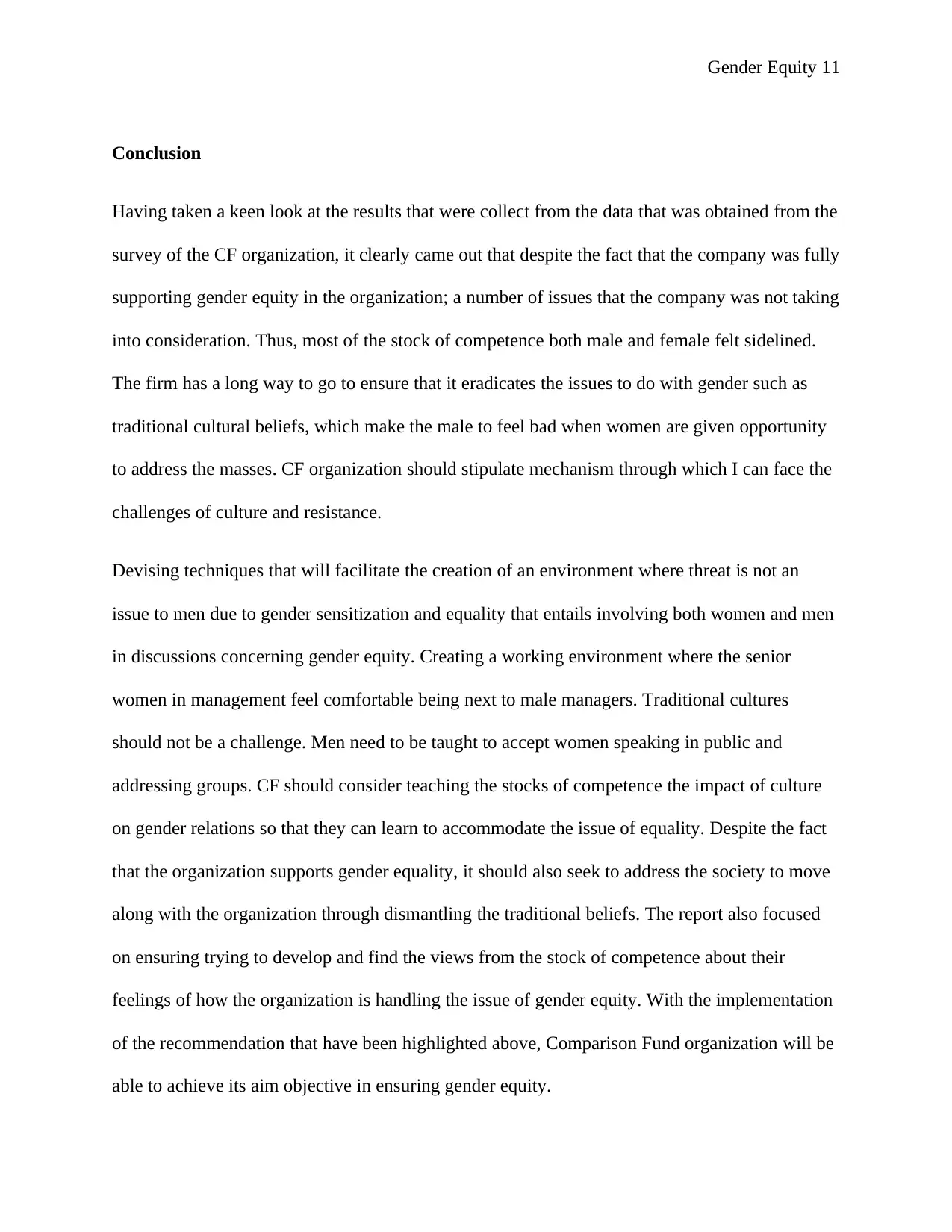
Gender Equity 11
Conclusion
Having taken a keen look at the results that were collect from the data that was obtained from the
survey of the CF organization, it clearly came out that despite the fact that the company was fully
supporting gender equity in the organization; a number of issues that the company was not taking
into consideration. Thus, most of the stock of competence both male and female felt sidelined.
The firm has a long way to go to ensure that it eradicates the issues to do with gender such as
traditional cultural beliefs, which make the male to feel bad when women are given opportunity
to address the masses. CF organization should stipulate mechanism through which I can face the
challenges of culture and resistance.
Devising techniques that will facilitate the creation of an environment where threat is not an
issue to men due to gender sensitization and equality that entails involving both women and men
in discussions concerning gender equity. Creating a working environment where the senior
women in management feel comfortable being next to male managers. Traditional cultures
should not be a challenge. Men need to be taught to accept women speaking in public and
addressing groups. CF should consider teaching the stocks of competence the impact of culture
on gender relations so that they can learn to accommodate the issue of equality. Despite the fact
that the organization supports gender equality, it should also seek to address the society to move
along with the organization through dismantling the traditional beliefs. The report also focused
on ensuring trying to develop and find the views from the stock of competence about their
feelings of how the organization is handling the issue of gender equity. With the implementation
of the recommendation that have been highlighted above, Comparison Fund organization will be
able to achieve its aim objective in ensuring gender equity.
Conclusion
Having taken a keen look at the results that were collect from the data that was obtained from the
survey of the CF organization, it clearly came out that despite the fact that the company was fully
supporting gender equity in the organization; a number of issues that the company was not taking
into consideration. Thus, most of the stock of competence both male and female felt sidelined.
The firm has a long way to go to ensure that it eradicates the issues to do with gender such as
traditional cultural beliefs, which make the male to feel bad when women are given opportunity
to address the masses. CF organization should stipulate mechanism through which I can face the
challenges of culture and resistance.
Devising techniques that will facilitate the creation of an environment where threat is not an
issue to men due to gender sensitization and equality that entails involving both women and men
in discussions concerning gender equity. Creating a working environment where the senior
women in management feel comfortable being next to male managers. Traditional cultures
should not be a challenge. Men need to be taught to accept women speaking in public and
addressing groups. CF should consider teaching the stocks of competence the impact of culture
on gender relations so that they can learn to accommodate the issue of equality. Despite the fact
that the organization supports gender equality, it should also seek to address the society to move
along with the organization through dismantling the traditional beliefs. The report also focused
on ensuring trying to develop and find the views from the stock of competence about their
feelings of how the organization is handling the issue of gender equity. With the implementation
of the recommendation that have been highlighted above, Comparison Fund organization will be
able to achieve its aim objective in ensuring gender equity.
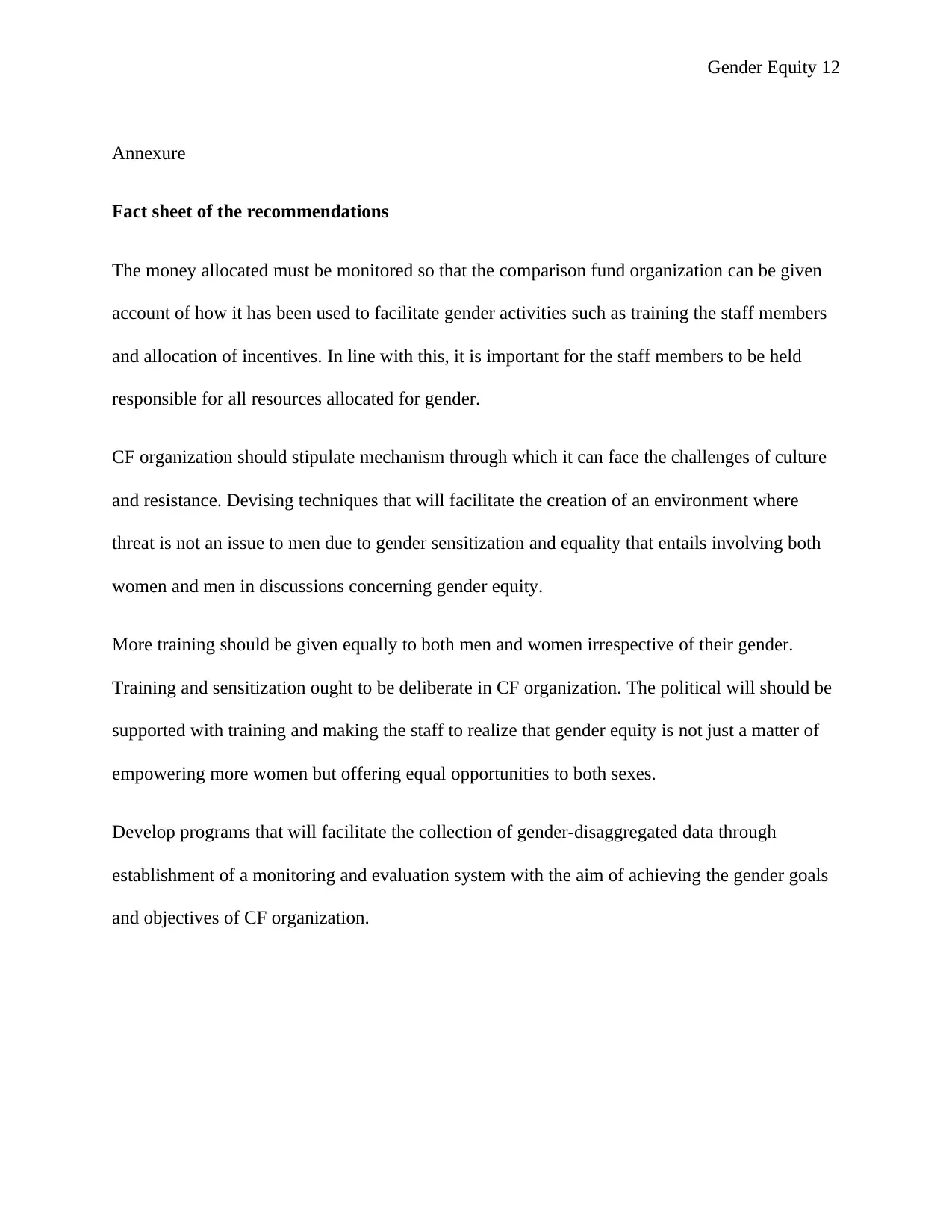
Gender Equity 12
Annexure
Fact sheet of the recommendations
The money allocated must be monitored so that the comparison fund organization can be given
account of how it has been used to facilitate gender activities such as training the staff members
and allocation of incentives. In line with this, it is important for the staff members to be held
responsible for all resources allocated for gender.
CF organization should stipulate mechanism through which it can face the challenges of culture
and resistance. Devising techniques that will facilitate the creation of an environment where
threat is not an issue to men due to gender sensitization and equality that entails involving both
women and men in discussions concerning gender equity.
More training should be given equally to both men and women irrespective of their gender.
Training and sensitization ought to be deliberate in CF organization. The political will should be
supported with training and making the staff to realize that gender equity is not just a matter of
empowering more women but offering equal opportunities to both sexes.
Develop programs that will facilitate the collection of gender-disaggregated data through
establishment of a monitoring and evaluation system with the aim of achieving the gender goals
and objectives of CF organization.
Annexure
Fact sheet of the recommendations
The money allocated must be monitored so that the comparison fund organization can be given
account of how it has been used to facilitate gender activities such as training the staff members
and allocation of incentives. In line with this, it is important for the staff members to be held
responsible for all resources allocated for gender.
CF organization should stipulate mechanism through which it can face the challenges of culture
and resistance. Devising techniques that will facilitate the creation of an environment where
threat is not an issue to men due to gender sensitization and equality that entails involving both
women and men in discussions concerning gender equity.
More training should be given equally to both men and women irrespective of their gender.
Training and sensitization ought to be deliberate in CF organization. The political will should be
supported with training and making the staff to realize that gender equity is not just a matter of
empowering more women but offering equal opportunities to both sexes.
Develop programs that will facilitate the collection of gender-disaggregated data through
establishment of a monitoring and evaluation system with the aim of achieving the gender goals
and objectives of CF organization.
⊘ This is a preview!⊘
Do you want full access?
Subscribe today to unlock all pages.

Trusted by 1+ million students worldwide
1 out of 15
Related Documents
Your All-in-One AI-Powered Toolkit for Academic Success.
+13062052269
info@desklib.com
Available 24*7 on WhatsApp / Email
![[object Object]](/_next/static/media/star-bottom.7253800d.svg)
Unlock your academic potential
Copyright © 2020–2025 A2Z Services. All Rights Reserved. Developed and managed by ZUCOL.





